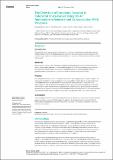Files in this item
The detection of lymphatic invasion in colorectal polyp cancer using D2-40 immunohistochemistry and its association with prognosis
Item metadata
| dc.contributor.author | Goodarzi, Mohammad | |
| dc.contributor.author | Mansouri, David | |
| dc.contributor.author | Kidd, Andrew C. | |
| dc.contributor.author | Orange, Clare | |
| dc.contributor.author | Duthie, Fraser | |
| dc.date.accessioned | 2021-03-30T15:30:05Z | |
| dc.date.available | 2021-03-30T15:30:05Z | |
| dc.date.issued | 2020-11-09 | |
| dc.identifier | 272544146 | |
| dc.identifier | ba3fa5bf-b221-4823-a1df-3fa194656326 | |
| dc.identifier.citation | Goodarzi , M , Mansouri , D , Kidd , A C , Orange , C & Duthie , F 2020 , ' The detection of lymphatic invasion in colorectal polyp cancer using D2-40 immunohistochemistry and its association with prognosis ' , Cureus , vol. 12 , no. 11 , e11394 . https://doi.org/10.7759/cureus.11394 | en |
| dc.identifier.uri | https://hdl.handle.net/10023/21741 | |
| dc.description | Funding was provided by The Jean Shanks Intercalated Grants 2015-16 for a total sum of £7,820 (no grant number available). | en |
| dc.description.abstract | IntroductionThe aim of this study was to compare the detection of lymphatic invasion using haematoxylin and eosin (H&E) staining versus D2-40 immunostaining on specimens from a retrospective cohort of patients with colorectal polyp cancer and to investigate the association of lymphatic invasion, detected by either method, with survival.MethodsSpecimens from patients with pathologically diagnosed colorectal polyp cancer were selected from the Greater Glasgow and Clyde Bowel Cancer Screening Registry for D2-40 immunohistochemistry staining. Clinicopathological information was retrieved from patient electronic records including analysis of pathology reports to determine if a lymphatic invasion was detected using H&E staining.ResultsOver 100 patients were included in this study with a median age at polypectomy of 66 years (range 50-76). All patients were followed up for a minimum of four years and five patients died due to colorectal cancer. The lymphatic invasion was detected in 8% of cases by H&E staining and 23% of cases with D2-40 immunostaining. Only D2-40-detected lymphatic invasion showed a statistically significant relationship with colorectal cancer-specific mortality using univariate analysis (p=0.01). Survival analysis performed separately by Cox regression demonstrated that lymphatic invasion detected by D2-40 immunostaining was associated with worse disease-specific survival (hazard ratio [HR] 14.07, 95% CI 1.57-125.97, p=0.018).ConclusionThis study shows that D2-40 immunostaining can improve the detection of lymphatic invasion in colorectal polyp cancer when compared to H&E staining. In addition, the lymphatic invasion detected by D2-40 immunostaining significantly associates with survival allowing it to be used as a prognostic indicator in colorectal polyp cancer. | |
| dc.format.extent | 9 | |
| dc.format.extent | 1199074 | |
| dc.language.iso | eng | |
| dc.relation.ispartof | Cureus | en |
| dc.subject | Immunohistochemistry staining | en |
| dc.subject | Colon cancer and colon polyps | en |
| dc.subject | Lymphatic spread | en |
| dc.subject | RC0254 Neoplasms. Tumors. Oncology (including Cancer) | en |
| dc.subject | RD Surgery | en |
| dc.subject | 3rd-DAS | en |
| dc.subject | SDG 3 - Good Health and Well-being | en |
| dc.subject.lcc | RC0254 | en |
| dc.subject.lcc | RD | en |
| dc.title | The detection of lymphatic invasion in colorectal polyp cancer using D2-40 immunohistochemistry and its association with prognosis | en |
| dc.type | Journal article | en |
| dc.contributor.institution | University of St Andrews. School of Medicine | en |
| dc.identifier.doi | 10.7759/cureus.11394 | |
| dc.description.status | Peer reviewed | en |
This item appears in the following Collection(s)
Items in the St Andrews Research Repository are protected by copyright, with all rights reserved, unless otherwise indicated.

